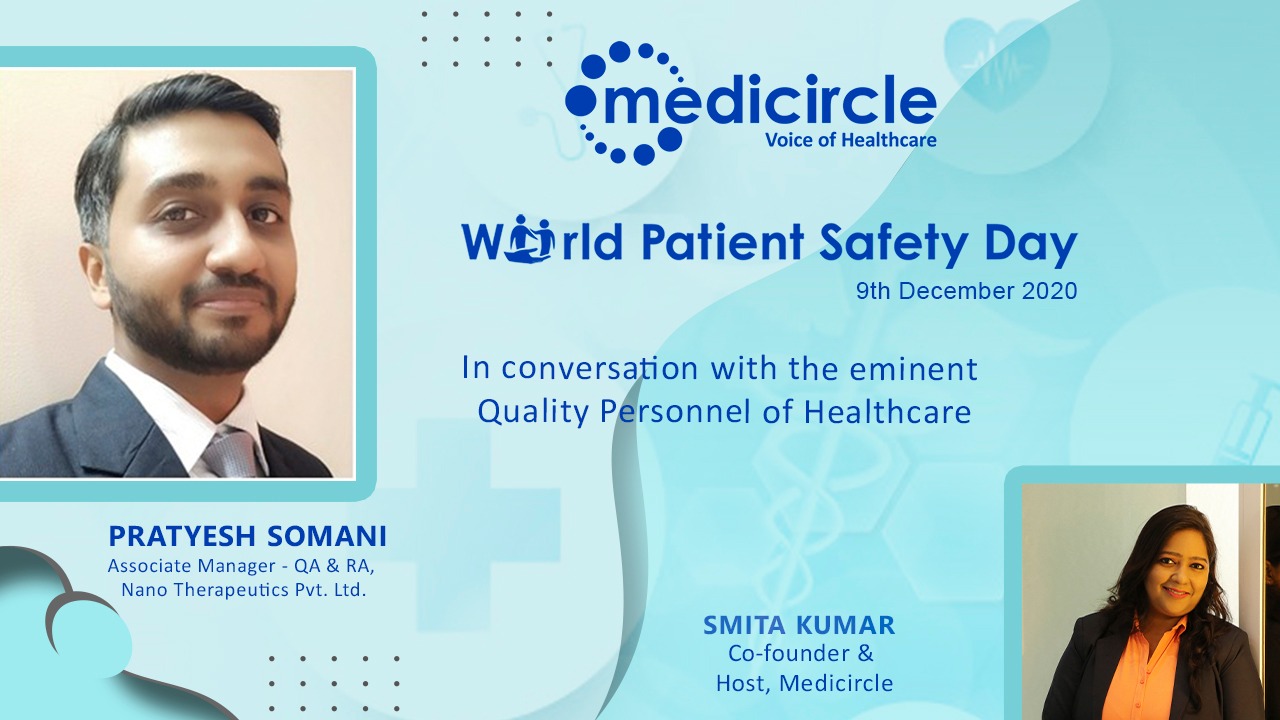Patient safety is the absence of preventable harm to a patient during the process of health care and the reduction of risk of unnecessary harm associated with health care to an acceptable minimum.
Pratyesh Somani, Associate Manager, QA & RA, Nano Therapeutics Private limited is associated with the medical device industry for the last 11 years. He started his career with the Quality Assurance department and parallelly got a chance to work with the Regulatory Affairs department.
COVID situation is a milestone event
Pratyesh sheds light on the subject, “Indeed, the Patient safety should be the utmost priority of any hospital and due care has been taken even in the COVID-19. This pandemic situation brought the issue again to the surface that if a patient was not properly taken care of by the hospital, it may lead to death. While the infection was starting to spread in our country, it was reported by many newspapers that many hospitals were caught in the shock that patient admitted just a couple of days back, died, even though few of them were not showing the severe case of infection. In this time span, we realized that sustaining a patient's life was never a sole duty of the hospital, but the patient's family as well. The cytokine storm which usually starts in the second week from the conception of the infection was not easy to understand at the beginning of this pandemic situation and we all almost believed that hospital didn’t care well and failed to perform their duty. But thanks to much research, now we learnt that how well this situation now can be handled with lesser efforts. So, I believe that the COVID situation is a milestone event to make us aware of how much patient safety is important and how well it shall be handled,” he says.
“Would I give this product to my family members?”
Pratyesh explains, “Being a medical device professional, my duty is to take care of the product quality and look after the product registration that fulfills all the obligatory requirements to get the product licensed to sell in India and overseas. By this, I believe that I contributed to making a product safe for health workers which has now proven to be safe and perform and they can intend to use without any hesitation. In nutshell, I always ask this question to myself before closing my assessment; ‘Would I give this product to my family members?’” he says.
Technological transformation is a welcomed move
Pratyesh talks on digital transformation in healthcare, “In 2004, a report was published by Centres for Disease Control and Prevention of U.S. Dept stated that, ‘During the twentieth century, life expectancy at birth increased from 48 to 74 years for men, and from 51 to almost 80 years for women’. We cannot ignore the fact that the introduction of digitalization in the healthcare system should be one of the reasons for this improvement. Technological developments presented us with many blissful surprises that helped to save a patient’s life with a large marginal rate. In fact, the improvisation in the established health care system also gives the hospital staff a hand in hand benefits to save patient life more efficiently. For example, digitalization in existing ambulances gives an added benefit to the patient, that life can now be taken care of by the hospital staff, from the moment he or she is brought into an ambulance. A patient with the critical conditions can be immediately treated by the nursing staff by audio-visually counselling with the Doctors, on the go. In summary, this technological transformation is a welcomed move to increase the patient safety rate,” he says.
Imposing standard operating procedures
Pratyesh shares his thoughts on ensuring patient safety from diagnostic errors, healthcare-acquired infections, medication errors, readmissions, wrong-site surgery, and communication, “When there is a man treating a man, there are always chances of errors in sense of inappropriate diagnosis, poorly sanitized equipment and operation rooms, erroneous operative skills, wrong medicines, and last but not the least, inaccurate communication. A combination of one scenario with any others will badly impact patient safety. When the health worker is surrounded by socioeconomic or any likewise factors which are affecting their lives negatively, they can put patient life in grave situations. So based on my experience, we can eliminate or minimize such patient safety issues by imposing standard operating procedures for all critical processes. These all shall be curated by seasoned Doctors and all concerned designees across the hospitals bound to follow them. The application of such procedures will work as a checklist too and so one can reduce the chances that risks’ patient safety,” he says.
References:
(www.cdc.gov/nchs/data/hus/hus04.pdf)
(Edited by Rabia Mistry Mulla)

 “I believe that the COVID situation is a milestone event to make us aware about how much patient safety is important and how well it shall be handled,†says Pratyesh Somani,Associate Manager, QA & RA, Nano Therapeutics Private limited.
“I believe that the COVID situation is a milestone event to make us aware about how much patient safety is important and how well it shall be handled,†says Pratyesh Somani,Associate Manager, QA & RA, Nano Therapeutics Private limited.









.jpeg)




.jpeg)

.jpg)













